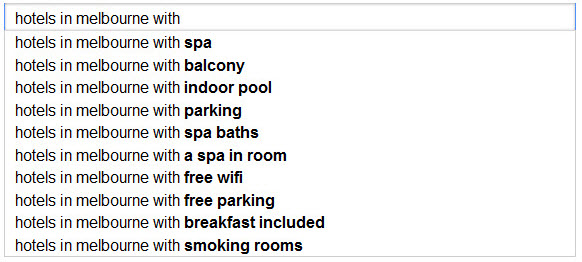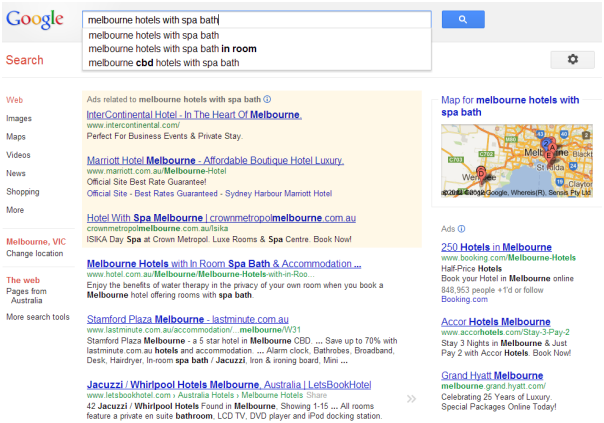A few weeks ago I looked at the general standard of Google PPC ads being served on Google (specifically in Australia), and found that the large majority of Google PPC advertisers seem to be missing out opportunities to connect with searchers who are at the later stages of the buying cycle and arguably more ready to convert.
For example, while many hotels in Melbourne might choose to show Google PPC ads for the keyword 'melbourne hotels', few seem to sufficiently target the long-tail. For example, people are searching for Melbourne hotels with a spa, Melbourne hotels with an in-room spa, Melbourne hotels with WiFi, Melbourne hotels with a balcony, and Melbourne hotels that are child friendly:

However, when searching Google for these phrases, hotels that satisfy these requirements do not make any mention of doing so in their PPC ads. Perform a mildly-specific search on Google, and by looking at the PPC ads, you wouldn't think there are any hotels in Melbourne which offer free WiFi, smoking rooms, balconies, in-room spas, or are child friendly:

Looking at the Google search results, it is clear that most PPC advertisers are missing out on a big opportunity to reach potential customers who are more informed about their needs and requirements, are further along in the buying cycle, and are arguably more likely to make a booking.
How to do PPC Properly
It isn't easy.
Targeting the long tail effectively can be very time-consuming. If you are a hotel chain wanting to develop a comprehensive long tail strategy on Google, imagine all the possible locations, descriptions, and permutations of keywords you will need to research. Not to mention all the different tailored ad messages you will need to create to effectively cater for each long tail need and requirement.
And as I pointed out in my last guest post, it can be a delicate balancing act to find a happy medium between having enough keywords to sufficiently target the long tail, and not having too many keywords to run into efficiency and management problems.
But even without getting into the tens of thousands of keywords, and tens of thousands of ad messages, there are still massive opportunities for PPC advertisers to effectively target the long tail, even with a more medium-sized campaign strategy.
It involves a little bit of extra time and effort, but it's worth it.
Strategy 1: Use Google's Autocomplete Suggestions
Open up Google, start searching for something related to a keyword you would like to show PPC ads for, for example 'Melbourne hotels', then take a note of what appears as Google's Autocomplete suggestions.
[For some weird reason, clicking through to the 'images' tab on Google will expand the list of Autocomplete suggestions to 10 or more].Continue typing, for example, 'Melbourne hotels with', and take a note of the suggestions. Go through the alphabet at a time, taking note of searches that appear, and continue your type and expand process until there are no further suggestions.
- Melbourne hotels with a...
- Melbourne hotels with a b...
- Melbourne hotels with a c...
- Melbourne hotels with b...
- Melbourne hotels with c...
- Melbourne hotels with d...
Repeat for other variations, going through the alphabet logically:
- Melbourne hotels for a...
- Melbourne hotels for a b...
- Melbourne hotels for a c...
- Melbourne hotels for b...
- Melbourne hotels for c...
- Melbourne hotels for d...
Your list of keyword suggestions should now evolve into a pretty comprehensive keyword strategy. Keyword themes which are relevant, such as 'free wifi', 'with balcony', and 'for kids' will now form a base upon which to permutate into further long-tail keywords. Themes which are not relevant, such as 'phone number', 'videos', and 'jobs', will form your list of negative keywords.
Once you have a list of long-tail keywords, paste them into Google's Keyword Tool for further keyword ideas.
You can then start to create highly targeted ads which cater for the wide range of different needs and requirements specified in your long tail keywords. For keywords which mention 'balcony', for example, make sure you ad messages mentions that balcony rooms are available. Similarly for 'free wifi', 'smoking rooms', and 'in room spa' etc.
The idea is to be extremely targeted, relevant, helpful, and engaging. Of course, it can be very time consuming to create a large number of tailored ad messages, but if done effectively, it can really pay off in terms of increase CTR, increased Quality Scores, lower CPCs, improved conversion rates, and a higher return on investment.
Strategy 2: Use Your Search Query Data
The strategy above should get you started on your targeted long-tail strategy. However, it is only once your new ads are live and collecting data that you can really start to develop and evolve your campaigns.
Once you have collected a good amount of data for your campaigns, run a search query report. Look how searches are being matched to your keywords. As a rule of thumb, you shouldn't have more than 10% of impressions or clicks going to a single ad group or keyword. If you do, it suggests there are opportunities for further long-tail keyword expansion.
When analyzing your search query report, it can all too often be overwhelming, and you might find yourself succumbing to analysis paralysis. To help mine your search queries for new long tail keywords, below are two techniques I find incredibly useful:
- Theme analysis - this involves extracting one, two, three, and four word themes from your search query data, then compiling a frequency report for each theme to compare the relative performance of each keyword theme. For example, there might be a lot of very different searches which all mention 'free wifi', but get hidden in the data when you look at each different search query individually. Pulling out themes, therefore, lets you see how searches which contained the words 'free wifi' performed as a whole. Incredibly powerful stuff.
- Broad match generation - this involves using your broad match keywords as a mechanism to create new exact and phrase match keywords, in an endless cycle of broad match generation and new keyword expansion. It's a great method for larger campaigns which could benefit from a bit of strategy and direction.
Conclusion
Don't be the PPC advertiser who constantly moans about increased competition on Google, increased CPCs, and poor ROI. These are just excuses for PPC advertisers who are not prepared to effectively capture the long tail. All it takes is some extra time and effort, and a bit of direction and strategy, and you could be on your way to long-term long-tail success.
If you liked this post, you might also enjoy Keywords without the Adwords Keyword Tool
